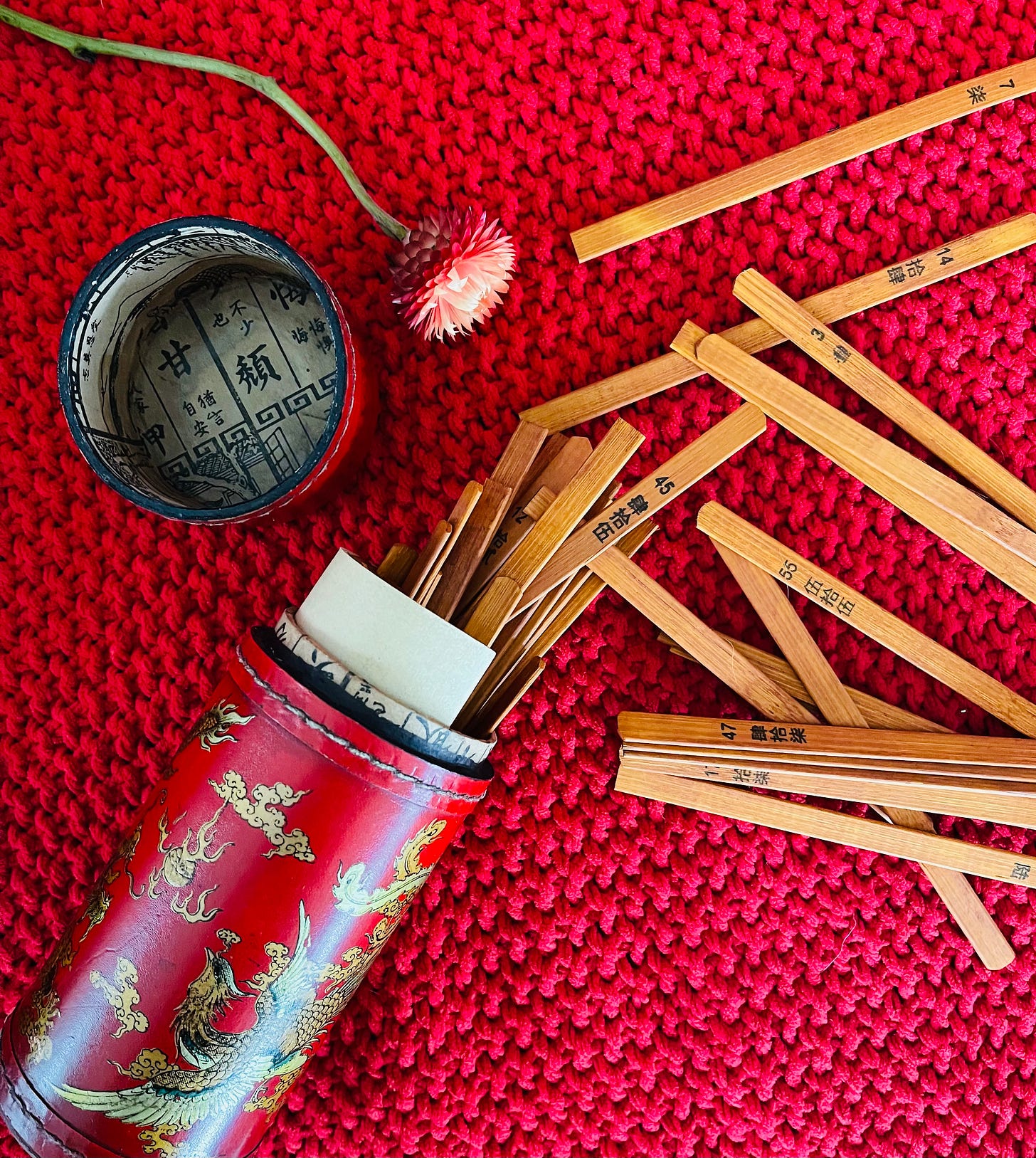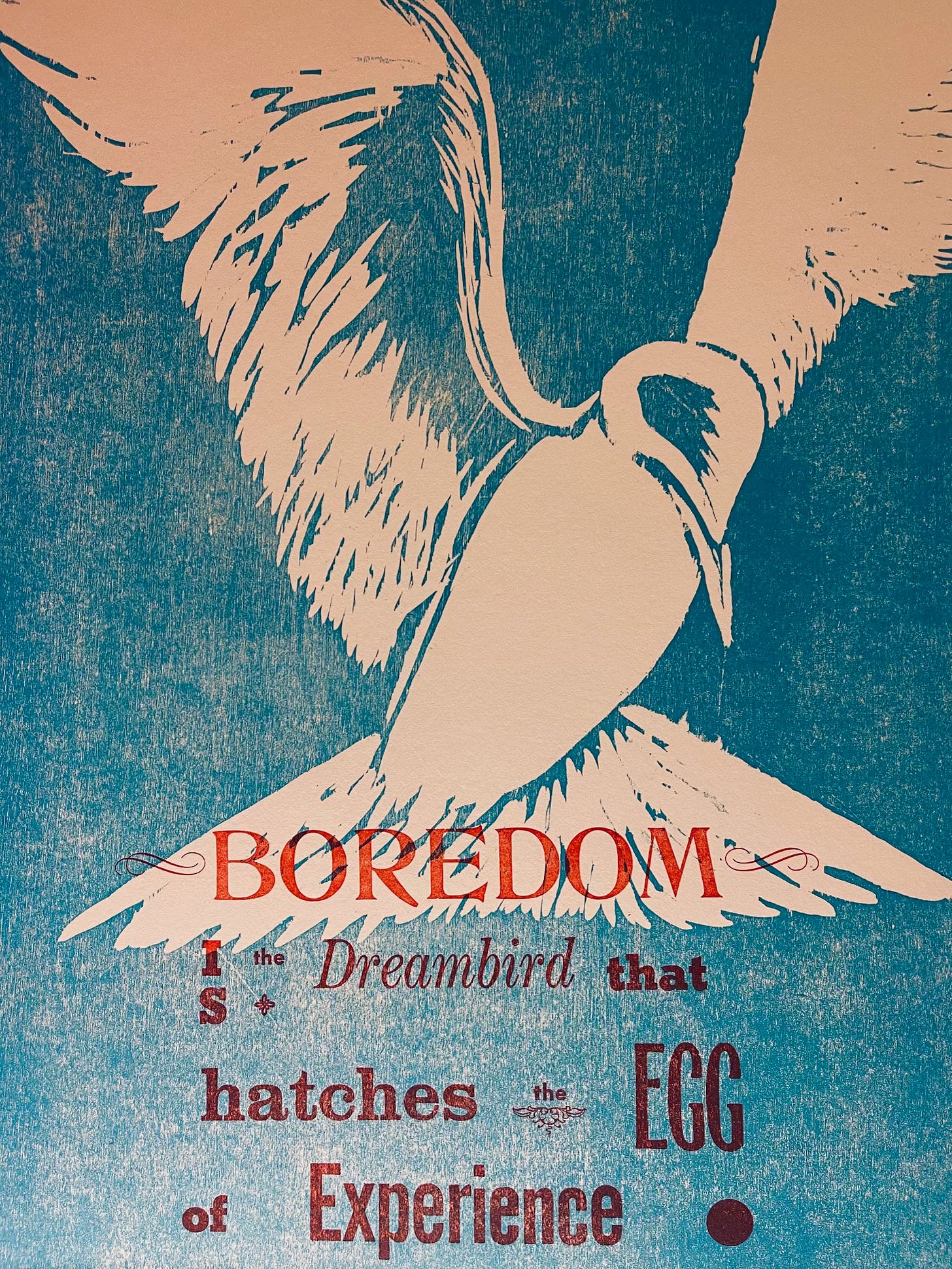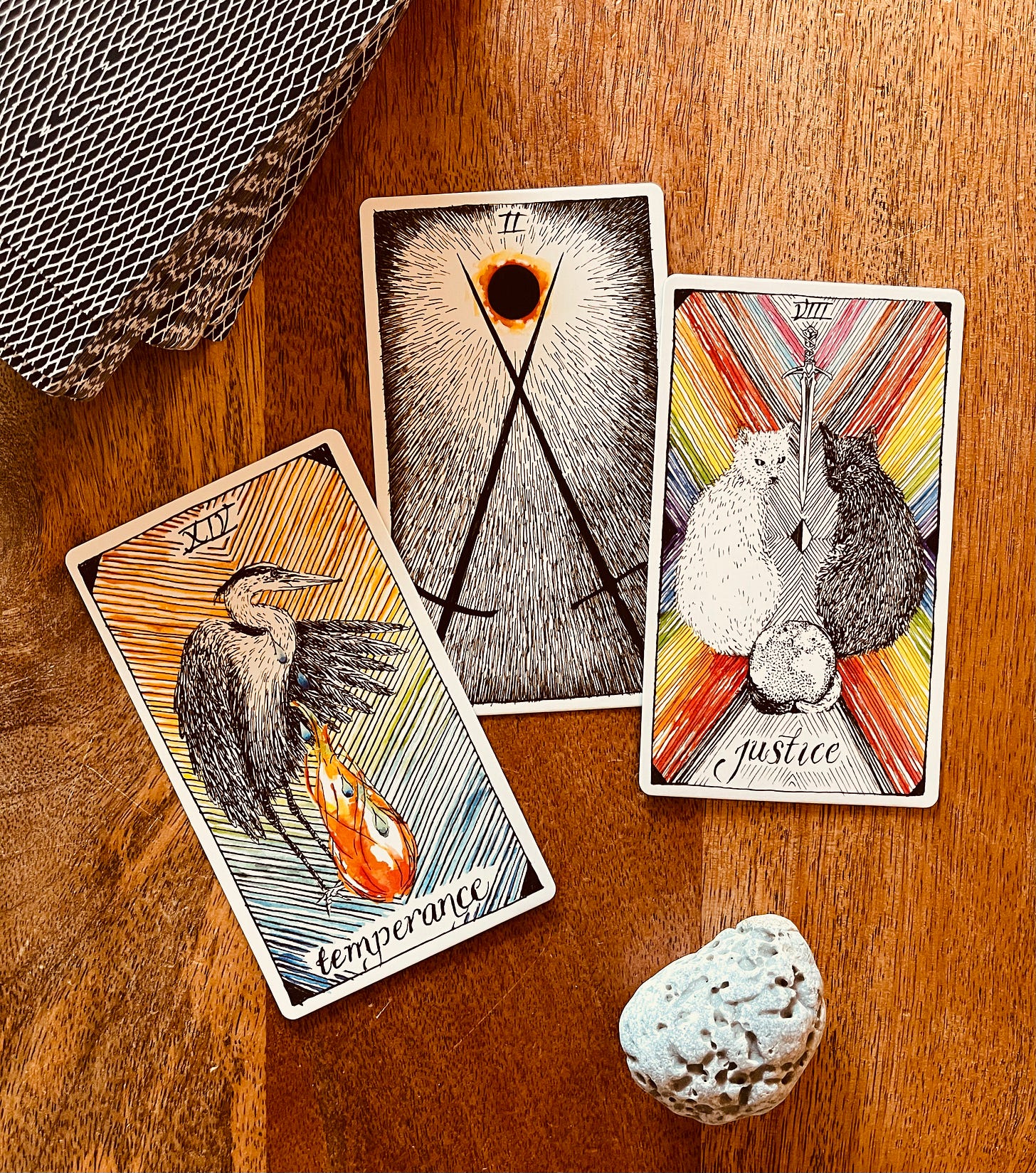Artist Interview with Writer and Educator Claire Campbell
Creating in Three Dimensions
In the deepest days of the pandemic, I was homeschooling, full-time parenting and hanging onto my writing practice by the skin of my teeth when I logged onto Claire Campbell’s zoom course on tarot for writers. I had never touched a deck, but my main character had revealed a penchant for divination (using 70s-era fortune-telling sticks). I thought it would be informative to give tarot a try. Bonus points if playing around with (sometimes spooky) images would crack through the mundane litany of my pandemic tasks, which mostly revolved around the construction and clean-up of kid snacks.
Fast-forward almost five years and I’m writing these regular missives on tarot/creativity/spiritual life; I probably don’t need to tell you that Claire’s approach to tarot struck a chord. It was incredible to learn that I didn’t have to be psychic to read the cards, that they could help to reframe and anchor my spinning thoughts, and that they could open up a portal to the imaginal realm that I (subconsciously) craved in my writing and my life.
I’ve continued to work with Claire in the intervening years as her coaching client, tarot querent, and as a member of her Bluestone Writers group, always benefitting from her intuitive, grounded approach to uniting craft with the ‘cosmic.’
Last week, as I sat down with her to talk more specifically about her writing and tarot practice, our discussion often danced between such binaries—
craft and cosmic
action and interiority
tedium and wonder
embodiment and mental flow
This reconciliation of opposites is deeply embedded in the symbolic imagery of the tarot itself. (See JUSTICE and TEMPERANCE.) My conversation with Claire reminded me that the alchemical interplay between sprit and matter, which the tarot teaches, lies at the center of every creative process. AS ABOVE, SO BELOW.
Social Imperative — Innermost Delight
As her client, I’ve come to associate Claire’s zoom box—backed by a shelf of abundant books, pocket-sized artwork, and a card to represent the lunar phase—with dramatic insights related to my own creative conjurings. It’s an extra pleasure to begin our conversation by asking about her current projects.
Claire describes transitioning from work on a horror novel (recently finished and out with agents) to the “true-fantasy-novel romp” that she’s in the midst of revising.
In the horror novel, Claire says, “some of the villains are literally like Elon Musk’s little lackeys…like little interns turned absolutely dangerous, as a form of chaos.” A good example of a kind of timely cultural criticism revealing itself in the story. “It’s a bit serious, even though it’s a romp in its own way.” It falls into the realm of work that feels “important,” Claire says, but with an affected, nasal tone—actively resisting any pretense.
In contrast, Claire’s voice brims with enthusiasm as she declares her fantasy novel: “just a damn good time.”
“It feels much more broad in a way. It doesn’t feel tied to a time period,” she says. This sweeping scope left more room for Claire to develop a main character (MC) that sought pleasure to an extent that surprised even Claire. “I am used to writing sharper protagonists,” she says, so when a beta reader remarked of the MC: “I like her ‘cause she’s soft and fun,” and that “she’s finding joy,” Claire was taken aback. “I cringed initially,” she laughs.
But after a beat, this feedback felt just right. “I was like…this is so great…as I said: that’s the whole point of the novel. A fun ride.”
Embracing the pleasure of the ride for its own sake, we both agree, can be subversive in its own right; particularly in a cultural context that routinely demands its members (especially women) suppress their desire in the service of others. This subtle resistance creates a generative tension: “I think it can be really good grist for the mill when you feel like something is maybe not quite what you’re supposed to do or not quite what you’ve been taught,” Claire explains.
“In grad school I always felt like a bit of a fish out of water because while I was desperate to write creative nonfiction, which is what I was studying at Sarah Lawrence…I was not a creative non-fiction reader like my peers were. They were like devouring the greats…They read stuff like Gore Vidal…current non-fiction and all the canonical stuff. And I had this revelation where I was like, oh, I read fantasy. That’s what I’ve always read…and I’m finally coming back around to it in my writing.”
I tell Claire about my own experience in graduate school—five years in, I had been racking my brain reading Goethe, Schiller, Gunter Grass, scouring medieval texts for their historical-cultural underpinnings, all in a language I was still struggling to comprehend, when a high school friend leant me her tween daughter’s copies of Twilight—complete with Edward’s name scrawled in hearts at the margins—and I was absolutely floored. I had forgotten that people actually read and wrote like that. It was pure ecstasy.
Claire is fully supportive of my indulgence in the “Twilight Cupcake.”
“It can be really important and really revelatory to think about what reading experiences shaped you, even from a really young age, when you’re trying to find focus in your writing life. It’s like: what are the anchors that I always go back to? For me, they’re just like pure magic, wild, made up stuff.”
Claire shares her memories of breaking from the work she did on her undergraduate thesis to gobble up C.S. Lewis’s The Space Trilogy; “they were just so weird!” Or when she had her first job out of college, which was with a wonderful employer but the work itself was “just sometimes a bit of a snooze.”
“One of my friends from childhood, whom I hadn’t spoken with in probably, like, ten years at this point, mailed me the first Outlander novel because she was like: ‘I just read this and the main character’s name is Claire, and I just thought of you.’” Reading Outlander became a touchstone of magic and wonder in her work day. “I was just sitting in the park with the pigeons; like reading was just this treasured kind of anchor in the day.”
I can’t help but notice this metaphor coming up over and over: ANCHOR. And I wonder aloud if the potency of our reading/writing experience is partly determined by the extent to which it helps rebalance whatever energy we happen to be sitting in at the time. An anchor, after all, is something that helps us resist the urge to drift off course—protecting us from moving too far with the current, whether out to sea or against the rocky shore. The anchor is the grounding tether that, ironically, helps keep us afloat.
Cerebral Swirl — Focused Action
Tarot, too, can function as an anchor.
Claire received her first reading, she tells me, almost by accident back in 2018. She’d planned to photograph her friend and writer, Jen Brown, as a character in the apocalyptic fashion blog that she wrote with her spouse called, “Have You Seen Me?” Jen was to portray a tarot reader, so Claire and her friends picked up an oracle deck by Kim Krans, drawn to its beautiful animal imagery. It turned out that Jen was very familiar with tarot and so after the photo shoot she gave the group a reading. “We were shook,” Claire says. “The cards were reading us all.”
About a year later, working as an organizer for the Writing Barn in South Austin, Claire connected with Cecily Sailer of Typewriter Tarot and began to learn from her approach to using the cards in creative practice.
“And then I had a really horrible job,” Claire laughs. “Anything magical [comes] out of having a horrible job.” During the peak of the pandemic she rotated in and out of an office with her colleagues completing mundane tasks—ending up with long stretches of time alone in the building with her hands occupied but her mind free. She listened through Lindsay Mack’s extensive back-catalogue of Tarot for the Wild Soul podcast episodes, while deep in the psychic experience of the pandemic when all of us, Claire says, were asking: “Who are we? What are we doing?”
“I think as writers we’re always looking for meaning, we’re always like: but what does it mean? What does it mean? And I think of Tarot as a reframing tool…that’s really grounding and also opens up possibility…It wakes you up a bit.”
This doesn’t mean that you always get the card, or the experience, or the energy you are hoping for when you go to your deck, Claire says. But whether you find the cards supportive, confronting, or encouraging, it’s all useful information. It also helps the overwhelmed mind to focus its attention.
“We love writing stories because we’ve got a lot of thoughts and a lot of feels and we got a lot going on in the brain pan…[Tarot] is a way to channel the swirl.” A card gives you a point of focus—sometimes that’s all you need to get your feet back underneath you.
Embodied — Ethereal
Claire credits tarot with helping her get through a particularly jarring heath crisis in 2021 as well as irrevocably shaping her approach to her writing. These days, however, Claire says she’s finding her time outdoors to be the most nourishing aspect of her spiritual practice. Whether working in her garden or leaving small offerings of flowers in gratitude while on a walk, the physicality of being in nature, she says, provides a necessary counterpoint to the mental labor of writing.
The body, the landscape, in turn, become important points of emphasis in Claire’s approach to craft. Often her courses ask writers to anchor into the body, crafting from the visceral experience of the character. Claire and I speculate for a bit on the relationship between intuition and the body—and I feel us coming upon one of the tarot’s oppositional unities again—spirit and matter.
When writing, Claire suggests, you can go with the emphasis that feels most familiar first. “Sometimes it’s like: I know exactly how she (or I or they) feel in this moment;” other times it’s easier to see it. Write where the energy is and add the supporting element in revision. “Once you have both it’s three-dimensional as opposed to just being one or the other.”
The Transcendent Third
I love this notion of a balanced duality giving rise to a vibrant, dynamic third element. To me it resonates with Jung’s notion of the “transcendent third” — a psychological state generated by holding space for tension between two opposing forces. As creators (and humans) we are always operating in this middle ground—between creative vision and execution, perception and reality, conscious and subconscious; so of course art that mirrors that dualistic state would develop its own vitality—its own life.

Claire is incredibly adept at holding space for this tension with her clients. Fittingly, her spring offerings deal directly with the dual requirements of creative life: robust labor and sacred rest. Her three-month “Spring Creative Commitment,” beginning March 3, builds on the seasonal sessions she gave at the turn of the year, focused on the magic of the tarot’s Nines and the energy of the Hermit. Now that wintry recluse encounters the springtime thirst for abundant growth.
“It’s about balancing that desire to complete something in the course of a few months…and then do that with a kind of gentle and nourishing approach to the body and spirit. And reinforce that with a community who’s on board for the same attitude and energy. It’s not like pushing through at all costs…it’s more like I really wanna do this thing and I want to do it with support and I wanna do it in a way that best fits my capacity.”
The course kicks off with a free webinar: “Winter to Spring,” this Saturday, February 22. (If you don’t have the opportunity to attend the webinar a recording is available on request.) “It’s going to be a chance for us to talk about: how are we doing this winter-spring thing? Where are we going? What are we doing?”
You can find out more about Claire’s mentorship offerings and tarot readings at Bluestone Writers. Or connect with her on Instagram or Bluesky.
In whatever way that you find to hold the tensions stretching through your life this season, I hope that the dance between is generative, transcendent, and full of joy.





